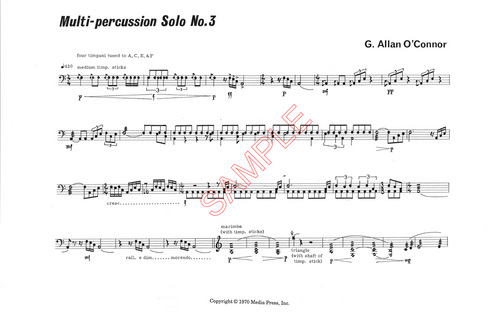Includes score and tape (mp3 file).
Print size: 11 x 17"
Review from Percussive Notes (2021);
Salute to the ’Fifties
Richard Trythall
“Salute to the ’Fifties” was composed in 1977 for solo percussionist and tape, combining the 1950s first wave of rock ’n’ roll with the emerging compositional aesthetic of European avant-garde composers. With a large setup on par with some of the midcentury seminal works for percussion, this piece requires a lot from the performer simply from a logistical standpoint. Sitting at around 12 minutes in length — the tape part does not start until after a brief solo opening — this solo would require a large space to rehearse and a talented percussionist willing to yell “shake” into a tam-tam to execute effectively.
The tape part is a manipulation of Richard Trythall’s earlier composition “Omaggio a Jerry Lee Lewis,” a 1975 musique concrète manipulation of Lewis’s “Whole Lotta Shakin’ Goin’ On.” Trythall’s new track distorts various elements throughout, while still giving clear glimpses of the original that peek through, allowing for a solid interplay with the rise and fall of rolls, leaping grace-note collections, and other similar percussive staples on the genre. Throughout the piece, the tape interjects at various time intervals and without a consistent tempo, suggesting a performance with a stopwatch rather than a metronome. At one point, the tape and soloist converge, rocking out to a chorus of Jerry’s “hit” with rimshots on 2 and 4. Trythall only unites the parts for a brief second, and then it returns to a chaotic juxtaposition of the affected rockabilly cover with spurts of drum rolls and atonal mallet outbursts.
Compositionally, the piece breaks into about four or five main sections. It begins with a roll-off on the snare drum alone, followed by a brief eruption of percussion instruments before the track starts. The opening tape material is simply the lyrics, modified and spaced over time, allowing for free interjections of the percussionist in the space. Later, the piece picks up the tempo and holds the traditional feel while the percussionist ignores that tempo. Eventually the soloist joins in the groove for a brief moment, and then the piece slowly disintegrates from there.
Although this piece may not be for everyone, the concurrence of these two musical styles in the 1950s provides for an interesting combination of two worlds into one solo.
—Matthew Geiger








